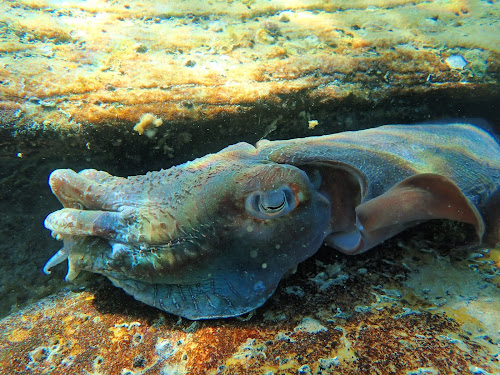📸: Saxon Nelson-Milton
Each year, one of nature's most bizarre marine orgies plays out along an 8km stretch of rocky reef at Point Lowly in the Upper Spencer Gulf region of South Australia. It's hard to imagine just metres from the shore an iridescent mass of over 200,000 majestic and highly intelligent Australian giant cuttlefish (Sepia apama) congregate to mate and then die. These giants are the largest of the world’s 120-odd cuttlefish belonging to the cephalopod group, which includes all squid and octopuses. Discovered by divers in the late 1990's, this location is the only place in the world cuttlefish are known to aggregate in such large numbers. This unique gathering every May-August is linked to the optimal rocky reef habitat which provides suitable crevices and caves which protect their eggs.
 |
Cuttlefish congregate to breed from May-August each year 📸: Catherine Larkin |
 |
| The cuttlefish embrace with arms entwined, sperm transferred from male (on right) to the base of the females mouth 📸: Catherine Larkin |
 |
| A Male (right) displays a striking pulsating zebra like pattern to woo the female 📸: Saxon Nelson-Milton |
The secret to their striking colour changing abilities lies in their skin, where millions of tiny pigment-filled cells called chromatophores are located. Muscles in these cells stretch to reveal the colors, and it's a part of why they can rapidly alter their skin colour and shape to mimic the pattern and texture of rock shelves and algal fronds. Chromatophores can be likened to pixels on a TV or computer screen, broadcasting the cuttlefish's inner thoughts. Whether it's courting, hunting or camouflaging, changes in skin cell pigments are controlled through direct action of their brain. It has been suggested that observing the cuttlefish skin is almost like reading its mind. If that's not cool enough, cuttlefish have three hearts, a doughnut-shaped brain, blue blood, a beak, eight arms and two (retractable) feeding tentacles. The closest thing to an alien on earth.
 |
| Australian giant cuttlefish can change the colour and texture of their skin 📸: Saxon Nelson-Milton |
Cuttlefish have been described as the 'rock stars of the sea' due to their active sex life, short life spans and impressive colouration. However, their short life span (12-24 months) and single spawning life history makes them particularly vulnerable to decline. Each breeding season is critical since the number of surviving eggs directly impacts the viability of the following year's population. After a population crash in 2013 a cephalopod fishing ban was introduced to the entire Northern Spencer Gulf. While no direct link between fishing pressure and the declining numbers have been drawn, populations have been rebounding since 2013, with exceptional numbers observed this year. Other influences that may have impacted numbers include fluctuating temperatures, salinity and pollution. Cuttlefish lovers are concerned now that the fishing ban in the Upper Spencer Gulf has been lifted, however, the permanent closure at the breeding site will remain.
 |
| The existing cephalopod closure area will remain in place to protect the world-famous Cuttlefish breeding site 📸: Catherine Larkin |
The cuttlefish aggregation is truly one the world's most exciting marine spectacles. Braving the chilly waters is a worthwhile endeavour to get up close and personal with these mystifying creatures.



Comments
Post a Comment